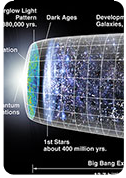Credits |
First WMAP article : Second WMAP article : Third WMAP article : Fourth WMAP article : WMAP Spacecraft ( picture ): Timeline of the Universe ( picture ): NASA / WMAP Science Team |
| Seven-Year Wilkinson Microwave Anisotropy Probe |
| January 25, 2010 |
 |
The 7-year WMAP observations and improved astrophysical data... |
The power-law index of the primordial power spectrum is n_s=0.963+-0.012, a measurement that excludes the scale-invariant spectrum by more than 3-sigma. The other parameters, including those beyond the minimal set, are also improved from the 5-year results. Notable examples of improved parameters are the total mass of neutrinos, sum(m_nu)<0.58eV, and the effective number of neutrino species, N_eff=4.34+0.86-0.88, which benefit from better determinations of the third peak and H0. We detect the effect of primordial helium on the temperature power spectrum and provide a new test of big bang nucleosynthesis. We detect, and show on the map for the first time, the
Sky Maps, Systematic Errors, and Basic Results |
![]()
